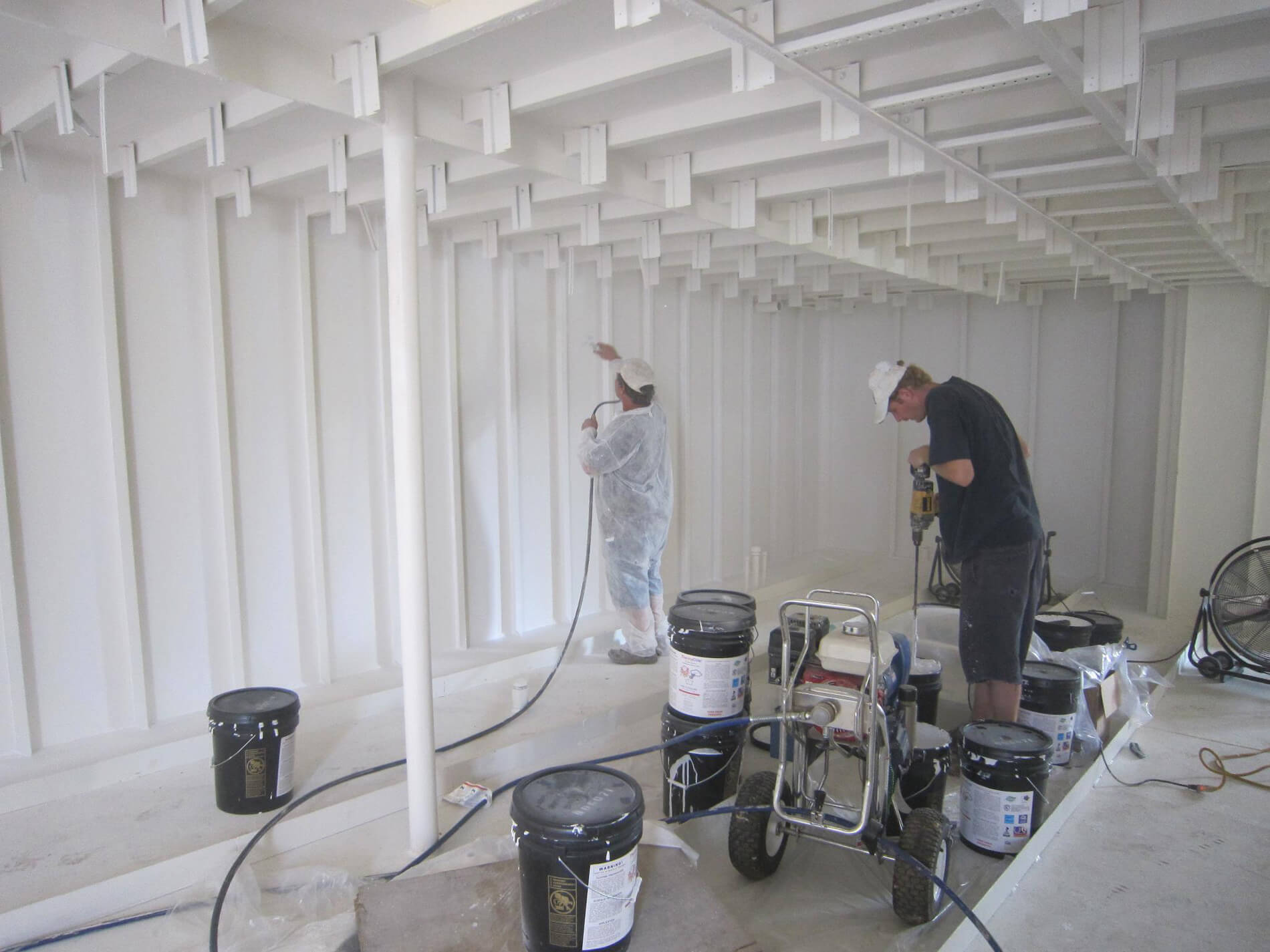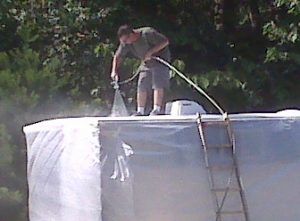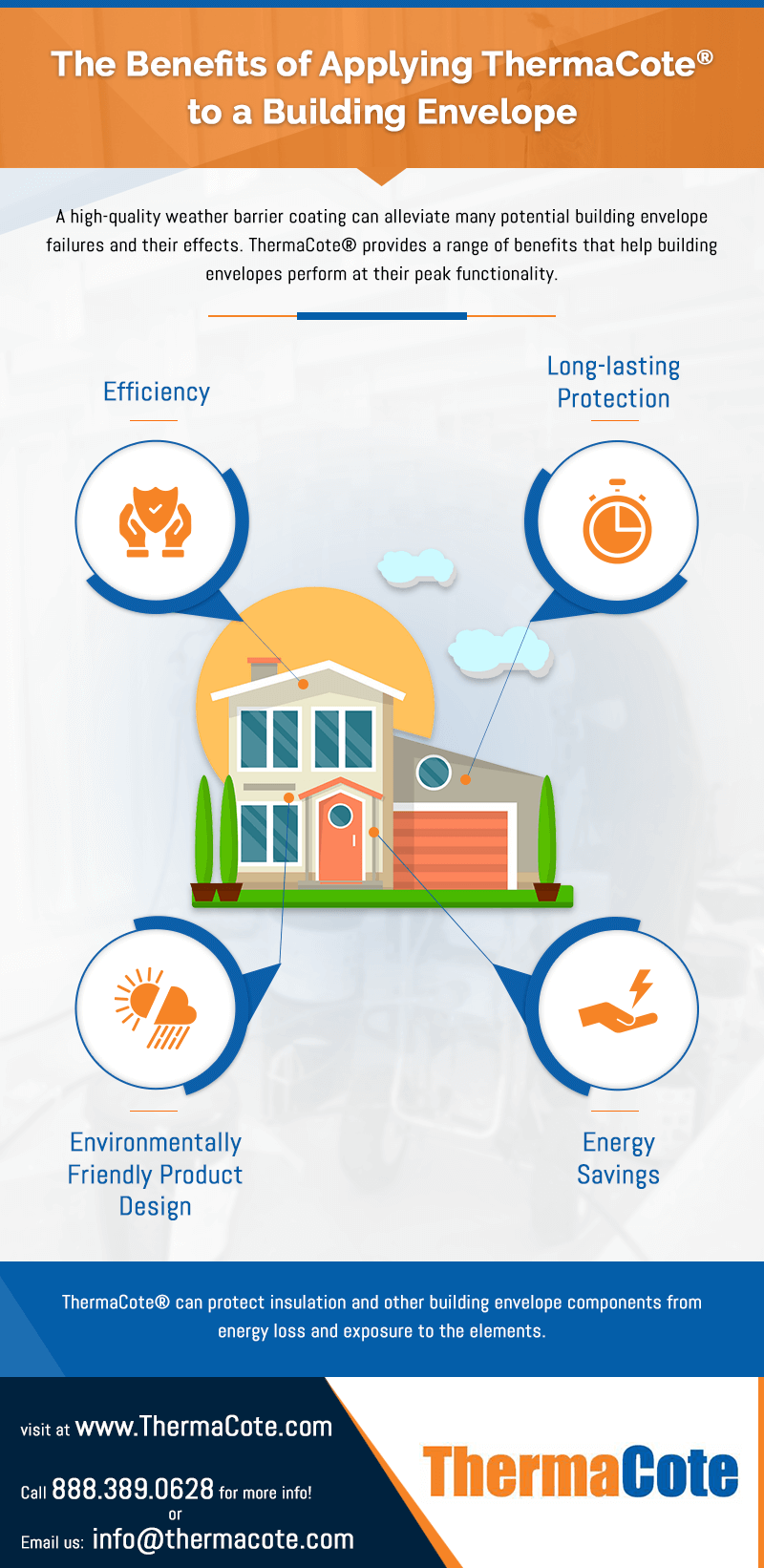- What is a Building Envelope?
- Considerations for a Properly Functioning Building Envelope
- Components of a Building Envelope
- Challenges, Hazards, and Maintenance of Your Structure
- Benefits of Applying a Weather Barrier Coating to a Building’s Envelope
ThermaCote®, Inc., is a global leader in weather barriers and protective coatings for both residential and commercial applications. We produce environmentally friendly solutions that reduce energy transfer and corrosion damage to a structure’s interior and exterior. Our weather barrier coating, ThermaCote®, is designed from ceramics to improve batt insulation and HVAC-R performance in structures. One of ThermaCote®’s critical applications is used for the improvement and sustainability of a building’s envelope.
What is a Building Envelope?
A building envelope encloses the structure to protect it from damage. Improving a structure’s envelope includes protecting the building from the elements, assisting in mechanical load support, and keeping the interior safe from outside forces or hazards. Building envelopes can also provide an aesthetic appeal with attractive finishes, while maintaining the structure’s interior condition.
One of the most essential functions of a building envelope is to facilitate climate control. Climate-controlled buildings have air conditioning and heating systems to make interior conditions comfortable and safe. Building envelopes keep the conditioned air in the building and help to maintain the internal climate and reduce energy waste, while also controlling ventilation and airflow.
Tight vs. Loose Building Envelopes
There are two broad descriptors for types of building envelopes: tight and loose envelopes.
Tight building envelopes let very little air leak out of the building they are protecting. The elements are tightly constructed to exact specifications, so there are few air gaps, drafts, or breaks in the building envelope’s layers. This shell regulates the air transfer out of the building, forcing air in and out through the predetermined vents and air conditioning system. These envelopes use sealants, caulk, and insulation to contain the air along the exterior walls, roofs, and floors.
The benefits of tight building envelopes include:
- Lower energy usage and costs. The conditioned air is purposefully trapped inside the building, so the building does not have to use excess energy to cool or heat new air.
- Less mold and mildew. Almost all of the potential air gaps that would allow moisture and rain inside of the building are sealed. Due to the envelope’s seal, moisture cannot accumulate in the building’s systems or wall gaps to breed mold or mildew.
- Better maintenance. The building’s conditions are very tightly controlled, so there is a reduced risk of decay, corrosion, and damage caused by potential infestations or temperature extremes. This lack of damage makes equipment and building substrate last longer with less extreme maintenance demands.
Many of these benefits are attributed to tight control over building ventilation and envelope coating. However, this relies on having multiple, well-functioning mechanical ventilation systems. These often have additional maintenance and energy requirements.
Loose building envelopes are less precise. The buildings have increased air gaps and uncontrolled points of entry. This increases the energy demands within the building, since treated air can escape and be replaced with drafty air or unwanted heat.
Loosely protected buildings also face an increased risk of mold and mildew. While loose building envelopes do have a higher level of natural air transfer and a corresponding rise in air quality, they can create unpredictable cold or hot spots in the building.
Many buildings have building envelopes with elements of both tight and loose envelope designs. They may have insulation and sealants to improve climate control, but also have undiscovered air gaps. Many buildings may also not have enough deliberate ventilation systems to facilitate good air quality.
Considerations for a Properly Functioning Building Envelope
To have a properly functioning building envelope, the system needs to have these three key elements:
1. Support
A building envelope must keep the building structurally sound. It comprises the building’s exterior. The building foundation should adequately support the weight of the building and hold it firmly upright, regardless of the soil composition or environment.
The walls must also be structurally sound, with loading-bearing—or purpose-built—walls providing enough support to keep the building safe. Almost every building is subject to regulations and building codes that construction must comply with. These codes set up basic safety requirements and account for regional concerns, such as hurricanes, tornados, or earthquakes.
2. Climate Control
Building envelopes must facilitate climate control. Air conditioning, heating, and air circulation systems treat the internal air to make it comfortable and safe. The building envelope ensures the air doesn’t escape and that external, untreated air doesn’t replace it.
Each building envelope should be constructed with the surrounding climate and regional considerations in mind. For example, a building in the northern United States needs more protection from cold air than a building in the Southeast, which has to contend with hotter, more humid air.
3. Finish
A building envelope provides aesthetic value. Commercial, residential, and industrial buildings need to maintain certain levels of curb appeal, and the building’s exterior plays a significant role in that. Using appealing exterior building materials and following popular styles provides for a high-quality finish. For example, a metal roof helps lock in air, but it also has a higher-quality appearance than a traditional shingle roof.
Components of a Building Envelope
Each of these considerations for creating and maintaining building envelopes involves several different components. Most of a building’s exterior elements are part of the total building envelope. Essential components of a building envelope often include the following:
- Foundation
- Wall assemblies
- Roofing systems
- Doors and doorways
- Other components, such as chimneys, vents, and windows
Challenges, Hazards, and Maintenance of Your Structure
Sometimes building envelopes fail. These failures may be gradual and incomplete, such as increased air drafts and poor air control. Other times, the building envelope failures can be immediate, overwhelming, or even dangerous.
Potential Causes of Building Envelope Failure
When building envelopes fail, it is often due to inefficiencies throughout the construction process. These possible causes of failure include:
Poor design. Every building needs a building envelope designed for its specific regions and needs. Designs that are too generic or don’t address all criteria may not adequately account for thermal movement, water exposure, and structural demands.
Improper materials. Building envelopes may use several different materials, such as chemical adhesives, glass, and metal. These materials can fail if they are exposed to moisture levels, temperatures, and stresses outside of their intended range. Materials may also be defective due to faults in the manufacturing process.
Low-quality workmanship. If the materials aren’t assembled correctly and according to the building’s design, they won’t perform as intended. Rushed construction jobs, work sites with poorly trained contractors, and jobs handled by multiple parties without adequate oversight can accidentally sabotage the integrity of the building envelope from the start.
Building envelopes sometimes fail because of weather conditions and natural disasters. Water can damage even tightly constructed building envelopes if the components are not adequately protected or sealed.
Attention to detail throughout building construction can reduce the risk of these contributing factors. Even if poor design, materials, or craftsmanship isn’t noticed during the construction process, building owners can still catch early signs of failure with frequent inspections or improvement projects.
Benefits of Applying a Weather Barrier Coating to a Building’s Envelope
A high-quality weather barrier coating can alleviate many potential building envelope failures and their effects whether it’s applied to the roof or elsewhere in the building envelope. ThermaCote® provides a range of benefits that help building envelopes perform at their peak functionality. These benefits include:
- Efficiency. Building envelopes that incorporate a weather barrier from the start can be designed to meet regulatory and environmental standards with fewer expenses, materials, and delays.
- Long-lasting protection. ThermaCote® resists weathering and corrosion. The weather barrier also withstands abrasion damage. Environmental and moisture damage won’t be able to degrade either the weather barrier or the substrate that it protects.
- Environmentally friendly product design. This product has a water-based formula. It has ultra-low VOCs and is produced according to best sustainable practices. ThermaCote® is MAS Certified Green™.
- Energy savings. ThermaCote® protects insulation from long-term degradation and moisture-related damage. This allows the insulation to protect the building and control air transfer better.
These and other benefits of ThermaCote® help give buildings long-term climate control, insulation, and protection from the elements.
What Can ThermaCote® Do for You?
Building envelopes must be well-designed and expertly constructed to provide long-term climate control, support, and aesthetic finishes. ThermaCote® can protect insulation and other building envelope components from energy loss and exposure to the elements. Contact our team today to learn more about how ThermaCote® can improve your structure’s building envelope.




